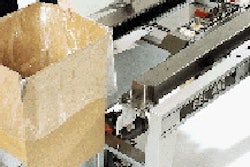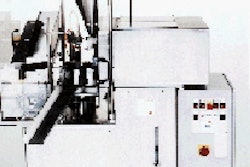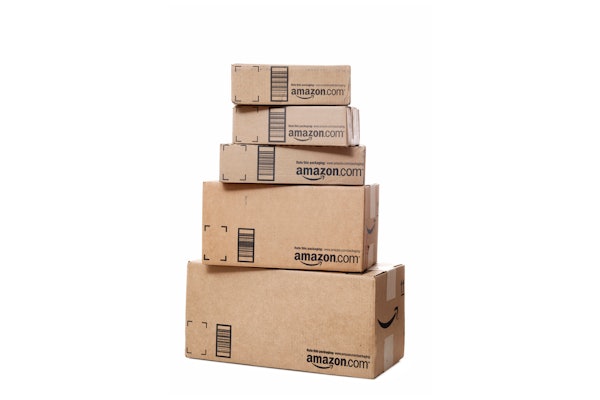An unusual multilayer paper/plastic structure is helping Switzerland-based Tiger Cheese launch its new single-serve Tiger Mini processed cheeses in the U.S. and in Luxembourg. Each 20-g (0.7-oz) pillow-shaped pack is made and filled on a vertical thermoform/fill/seal machine. Five pouches are manually inserted into a plastic bag for merchandising. Tiger Minis are often sold refrigerated. But because they're shelf-stable, they don't require refrigeration. The packs carry a six-month shelf life.
Tiger Cheese is the first to use the new structure, according to its maker, gruppo X di X gruppo (Venice, Italy). Gruppo worked with Elopak (New Hudson, MI) to develop a material for the cheese that would run on Elopak's Unifill TR86 tf/f/s machine. Tiger Cheese added the machine late last year at its Langnau, Switzerland plant, to introduce Tiger Mini cheese in its home country in February '98. Tiger sees strong sales potential for Minis in the snack food market.
The most unusual part of the structure is its two layers of Mould Paper, a 100% cellulose material that gruppo says is produced from wood via a traditional paper pulping process at a mill in northern Italy. Gruppo owns the mill, as well as the facility that extrudes the structure's plastic layers.
From the outside-in, the laminated 12.5-mil structure includes 90-ga low-density polyethylene that's flexo-printed in four colors/100 g/sq m Mould Paper/60-ga LDPE/100 g/sq m Mould Paper/coextrusion of ethylene vinyl alcohol, LDPE and DuPont's (Wilmington, DE) Bynel®. While paper thickness isn't measured in mils, it makes up the bulk of this structure.
Besides providing good seals, the inner coex layer's Bynel offers an easy-to-peel opening. The pack opens much like a clamshell, remaining "hinged" along its base.
"The package is convenient to open and uses new packaging materials," says Pierre Gani/re, Tiger Cheese's director/marketing manager. Founded early this century, this maker of processed cheese and fondue products is situated in Switzerland's Emme valley, which is known for its Emmental cheeses. Tiger Cheese markets in 30 countries and is a major supplier to Swiss retailer Migros as well as Swiss Co-op.
In the U.S., Tiger Mini cheese first entered East and West Coast test markets via international food importer/trader Atalanta. The Elizabeth, NJ, importer now says the cheese is available at supermarkets and convenience stores throughout much of the U.S.
Thermoforming paper
Gani/re tells Packaging World, "We are not aware of any other thermoforming application in which paper is used. We are sure this uniqueness provides [our product] with a point of differentiation in the market. That's an important factor in the introduction of the new Tiger Minis [because] in the areas where we sell [the market] is very competitive."
Surprisingly, Gani/re says the addition of paper in the structure was made for environmental reasons. "Paper is perceived as more environmentally friendly, especially in Switzerland and Germany." He says this perception originated many years ago as plastics were chastised for the gases they emitted during incineration. "That's changing," he says, "but paper is still seen as more friendly because it's taken back and reused."
He says paper offers two other key benefits, as well. "It protects the cheese better from light than plastic," and it provides tactile advantages. In a report published in an April issue of Swiss packaging publication Pack Aktuell, Tiger Cheese business manager Samuel Roethlisberger noted:
"Plastic does not have such a pleasing 'feel.' This packaging stands out from other individual portion packaging, looks attractive and attracts attention. From a convenience standpoint, the packaging is ideal for the snack market because it can be easily opened." The structure also prevents the cheese from sticking to the material.
The package's shape and the pillow-shaped cheese inside distinguish it from competitive non-sliced processed cheeses, which tend to be packed in triangular-shaped wedges, usually overwrapped in printed foil, and packed like slices of pie into an outer paperboard carton.
That type of package is also marketed by Tiger Cheese. But Tiger Mini cheese packs are hand-packed into a printed LDPE bag. Since introducing the product, the company has used pre-made bags from Elag (Kirchberg, Switzerland). In the U.S., Elag is represented by Developmental Concepts (Fenton, MO). However, Gani/re says new Italian-made machinery will soon be added to automatically fill packs into a smaller outer bag, made from rollstock. Presumably, that change will lower labor and material costs and lessen the burden on the waste stream.
Vertical tf/f/s process
The rollstock material manufactured by gruppo is sourced by Tiger Cheese through Elopak. For this application, two unwinds are used on the TR86 machine. Elopak refers to the process as "twin-sheet thermoforming," where each of the two sheets forms one half of the cheese package. The same plastic/paper structure is delivered from two separate unwinds, first upward then downward and parallel to one another.
As the rollstock descends separately, it passes through a preheating station, then indexes downward to a pressure-forming section. Proprietary, computer numerically controlled (CNC)-machined tooling is used for the mold halves that form the packs. The seven-up tool matrix forms seven packs across the web at a time. Each mold half is made up of seven female cavities. As the molds close on the two preheated, stretched sheets, air is blown into the mold, blowing the material from one sheet into one mold half, while simultaneously blowing the material from the second sheet into the other mold half. The material is then sealed around most of the periphery of the seven packs across the web, with the exception of the top, which remains open to accommodate downstream filling.
The intermittent-motion machine then indexes the material downward, cutting horizontally across the top of the seven formed and partially sealed packs. This separates the group of seven from the two webs, which continue to the next forming and filling cycle.
Meanwhile, the machine carries the initial seven-pack group horizontally to the dosing station where the group is lifted upward so that each of the seven packs accommodates a filling nozzle for bottom-up hot-filling of the liquid cheese at 194°F. Printing on the packs indicates the cheese is sterilized via the ultra-high-temperature process. Gani/re estimates the temperature at around 240°F. This process kills bacteria, providing the cheese with shelf stability.
During the fill cycle, the machine indexes the group downward, freeing the nozzles to fill the next group. The first group of seven filled cheese packs is then heat-sealed across the top before indexing into a punch station that cuts the individual packs from the group of material. These packs are then manually placed into the printed LDPE bag, sealed, case-packed, palletized and readied for distribution.
Up to the challenge
Gani/re estimates that the machine produces as many as 70ꯠ portion packs in an eight-hour period. That's at cycle rates of just over 20/min. He admits his company's lack of experience with the machine, and the unusual material, has tested Tiger Cheese.
"Using paper in a thermoformed structure is a challenge," he says, but he believes the research and testing done between gruppo and Elopak have made the process work. Once the two suppliers tested the material, it was sent to Tiger Cheese for evaluations that led to its commercial use.
According to gruppo product manager Marion Sterner, Mould Paper is designed to stretch approximately 20% in the machine direction, 16% in the cross direction. She says the material has been tested successfully on several commercial thermoforming, tube forming and coating machines and can be used for both food and non-food applications, particularly for use in trays.
Since launching the small cheese packs, primarily for an "under-30" audience, Tiger Cheese has also introduced Fit & Fun snack cheese in the same structure. Only the graphics are different. The Tiger Mini has a solid yellow background, with the word "Tigre" repeated diagonally across one half of the pack. The other half is adorned with the words, "Tiger Mini" in red, just below a depiction of a tiger gripping a barrel of cheese. Fit & Fun, sold in a seven-pack and aimed at health-conscious adults, shows the face of a cow. Vertical lines are visible in the background on both halves of both packs. These lines look similar to the undulations common to linerboard.
"One of the exciting things is that we can make different product and package shapes for the market," Gani/re contends. "We plan to introduce a Tiger-shaped pack soon and a version of the Fit & Fun for the U.S. market." He also hints that additional Unifill equipment may be added in the future.
"Tiger Cheese decided to buy the [initial] machine to provide convenient packaging and take advantage of a new material that our customers perceive as more pleasing. We hope the payback for the investment in this Unifill machine is about five years." The timeframe, he concludes, "depends on the success of the new product."
At press time, PW had no sales figures, but judging by the expansion of the Minis into new markets, and the cheese producer's plans to add new varieties of the snack cheese, it appears that Tiger Cheese is headed in the right direction.






















